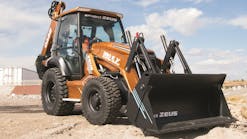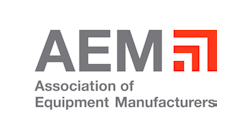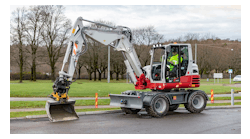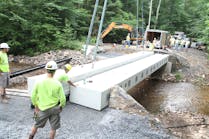Most of you will recall Kilroy. If you’re not familiar with the historic icon, take just two minutes right now and watch this video before reading the rest of this blog.
In my estimation we need something akin to Kilroy that will inspire, challenge, remind, and maybe most importantly alert people to the current condition of the nation’s infrastructure and of the dire need to fix it. We need a simple symbol and message that will continue to resonate across governments, communities, and industries.
With a modern-day Kilroy absent, we have Infrastructure Week.
Infrastructure Week is from May 16 to May 23, 2016. It is a national week of events, media coverage, and education and advocacy efforts to elevate infrastructure as a critical issue impacting all Americans. It is comprised of more than 100 affiliate organizations from all sectors of the nation’s economy and civil society. Forester Media, the publisher of Grading & Excavation Contractor magazine, is an Infrastructure Week affiliate. And Grading & Excavation Contractor magazine has already started the conversation.
A couple of weeks ago, I reached out to various manufacturing executives and industry experts with four questions regarding the state of our infrastructure. A number of responses have come in from the Association of Equipment Manufacturers (AEM), CASE, John Deere, Volvo, Trimble, etc.
Here now is the exchange with AEM President Dennis Slater:
Grading & Excavation Contractor (GX): Which infrastructure projects should be given priority? Roads and bridges? Dams and levees? Water supply? Electrical grid?
Dennis Slater (DS): AEM represents 900 equipment manufacturing industry member companies with more than 200 different product lines from the agriculture, construction, forestry, mining, and utility sectors. These companies rely on all types of infrastructure, not just to perform safely and efficiently in its individual parts, but also to function together as a system. AEM recognizes that with a finite set of resources available to address such widespread need, critical and strategic decisions will need to be made in the short term to keep the system functioning properly.
However, building on this, AEM recognizes the need to develop a national plan that addresses the entire US infrastructure system in the long term. Through AEM’s Infrastructure Vision 2050 initiative, we are looking beyond the six-year funding cycle at aspirational ideas and conceptualizations for what US infrastructure could look like and how it could better serve our communities and economy in the future to meet the needs of the next generation and beyond. We hope to move the conversation beyond the immediate such as potholes and congestion, and proactively seek ideas to develop recommendations for what’s next.
GX: Is there a solution to long-term infrastructure funding?
DS: The gas tax is currently the primary revenue source for federal funding of surface transportation projects, but it hasn’t kept pace with the rate of inflation and that’s led to a decrease in dedicated funding for surface transportation projects. Increased vehicle fuel efficiency standards have exacerbated this gap between funding and need even more. In the short term, AEM supports raising the gas tax to restore its purchasing power and to maintain the user-fee principle. In the long-term, finding a solution to the funding question is going to take leadership, political courage, and the development of a common vision for what’s next for US infrastructure. AEM is working to provide a clear articulation for how future funding could most economically and efficiently be used to bring US infrastructure up to the world-class standard we need. This country needs a comprehensive plan for policymakers to point to and use to reassure the general public that their hard-earned tax dollars are going to be used wisely and put towards the right projects.
GX: What kind of harm is the current state of our infrastructure doing to the economy and the community?
DS: Roads, bridges, waterways, and ports are all vital for transporting goods to market, including global ones, so the current state of US infrastructure threatens the future health and viability of all industries that rely on them, and the communities that rely on those industries for jobs. The gradual deterioration and continued neglect of updating those systematic components pose a real challenge to future growth and prosperity for all of us. Companies incur added expense and time to get their products to market as the infrastructure deteriorates, making US companies less competitive and less likely to expand or even stay in the US. And farmers are less able to compete due to the higher cost of getting goods to the global marketplace. The fact that this harm may not be as immediately felt as safety issues, such as the collapse of a bridge, should in no way diminish the need to act and implement a national plan to fix and even rethink US infrastructure.
GX: What can various government entities—from local to federal—do to attract private sector support and investment?
DS: It’s more of a question of what we all can be doing to attract attention to this issue. Within both the private and public sector, anything that can be done to encourage innovation and disruptive thinking in this realm should be considered. It starts with opening the door to non-traditional ideas from non-traditional stakeholders and ensuring that people who haven’t been a part of the conversation have the opportunity to take part. That’s why, as part of the Infrastructure Vision 2050 initiative, AEM is partnering with HeroX to sponsor the Infrastructure Vision 2050 Challenge, an incentivized crowdsource competition seeking big ideas for what the future holds for US infrastructure. The challenge will run all this year, and we hope to hear from expert and non-expert innovators alike with their ideas.
GX: Thank you, Dennis.
Next week I’ll let you know how a Volvo executive answered the same four questions.
The issues go well past grading and excavation. All of Forester’s publications, Stormwater, Erosion Control, Business Energy, Water Efficiency, and MSW Management have asked the same four questions of their various industry executives and experts. All of the discussions will be revealed here on Forester Network leading up to Infrastructure Week 2016.









